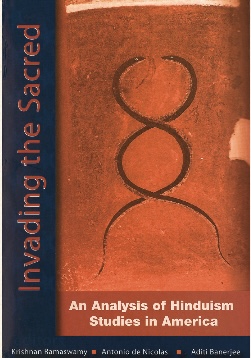BY JEFFERY LONG
This provocative book covers the awakening of the American Hindu community to troubling trends in the academic representation of Hinduism. Spearheaded largely by Hindu scholar Rajiv Malhotra and his postings on the website www.sulekha.com, a movement has emerged in recent years among Hindus in America which has expressed shock and outrage at the ways in which Hindu beliefs, practices, and sacred figures are depicted in writings by scholars associated with some of the most prestigious institutions of higher learning in this country. From one scholar’s Freudian interpretation of Lord Ganesha’s trunk as a “limp phallus ” to an award-winning book which depicts Sri Ramakrishna as a homosexual pedophile, academic writing in the field of Hindu studies has produced a number of claims deeply offensive to Hindu sensibilities, bearing little or no resemblance to how Hindus understand Hinduism.
Academia’s unseemly claims are misleading, especially if seen as representative of Hindu traditions, and not as the idiosyncratic interpretations that they are. They also tend to create a strongly negative impression of Hinduism in the minds of the many non-Hindus who read them. Such representations thus fuel what the authors of this volume term Hinduphobia–that is, bigotry and antipathy toward Hindus and Hinduism.
This is not to say that scholars do not have the academic freedom to pursue any interpretation they like of the phenomena they study–a freedom foundational to serious intellectual discourse. But this freedom is counterbalanced by a responsibility to uphold standards of integrity and rigor in presenting material accurately and fairly.
When the material that the scholar studies consists of the beliefs and practices of a religious community, particularly a minority community, one could argue–though this is a point that is still debated in the field of religious studies–that the scholar has even more of a responsibility to construct representations that are not only accurate and fair, but that do not lend themselves to the abuse and harassment of that community–as some work in Hindu studies has lent itself to abuse on evangelical Christian websites where Hinduism is depicted as a violent, hypersexual and “filthy ” religion.
Invading the Sacred incorporates a vast body of material that engages with the academic representation of Hinduism from several different perspectives, using a variety of methodologies. Some of the best articles are those by senior scholars of Hinduism who are themselves Hindu and who have been involved with academia for some time. In his preface, Arvind Sharma presents a thoughtful and even-handed overview of many of the conceptual issues involved in the current debate over Hindu studies. S.N. Balagangadhara, in an essay on the Biblical underpinnings of “secular ” social sciences, lays out the beginnings of a fascinating and provocative thesis that Christian theological assumptions are so deeply embedded in the social sciences that a truly sympathetic representation of Hinduism is impossible from within the confines of the Western academy. This, of course, raises the tantalizing question of what an authentic Hindu social science might look like.
The less intellectually compelling material in the book seeks to turn the Freudian methods of those scholars whose work is problematic against the scholars themselves. The problem, of course, lies with the inherent flaws of the Freudian methodology itself. Just as this methodology can lead one to see a phallus where there is only an elephant trunk, it can also lead one to see Hinduphobia where there may only be a lack of empathy and an arrogance founded on the habit of not having one’s scholarship challenged. The scholars involved have inevitably interpreted such “reverse analysis ” as a personal attack, rendering this approach counterproductive.
The book also rests too many of its arguments on racial distinctions between Indian Hindus and “white ” scholars of religion. Assuming that all Hindus are Indian diminishes the universal appeal of Hinduism. Also, much of the material in the book is repetitive. It would have benefited from further editing.
The most disturbing point to emerge from Invading the Sacred is the lack of a rigorous peer review process in the field of Hindu studies. The citation errors in Courtright’s book on Ganesha and the translation gaffes in Kripal’s book on Ramakrishna are not a question of offended sensibilities or insider/outsider politics. They are a matter of scholarly rigor and academic integrity.
The question that Invading the Sacred does not address, but which it will raise in the mind of the thoughtful reader, is “Where do we go from here?” This book will do a tremendous service to Hinduism if it encourages more intelligent young Hindus to pursue the study of Hinduism rather than flocking to computer science, engineering, medicine and law. A greater Hindu presence in the academy of religion will allow more authentic representations of Hinduism to enter and influence the scholarly conversation.
Dr. Jeffery D. Long, PH.D, is an Associate Professor of Religious Studies at Elizabethtown College, Pennsylvania, USA.
Invading the Sacred: an analysis of Hinduism studies in America, edited by Krishnan Ramaswamy, Antonio de nicolas and Aditi Banerjee published 2007 by Rupa and Co. publishers, 7/16 Ansari Rd, Daryaganj, New Delhi, 110 002. 545 pages.
